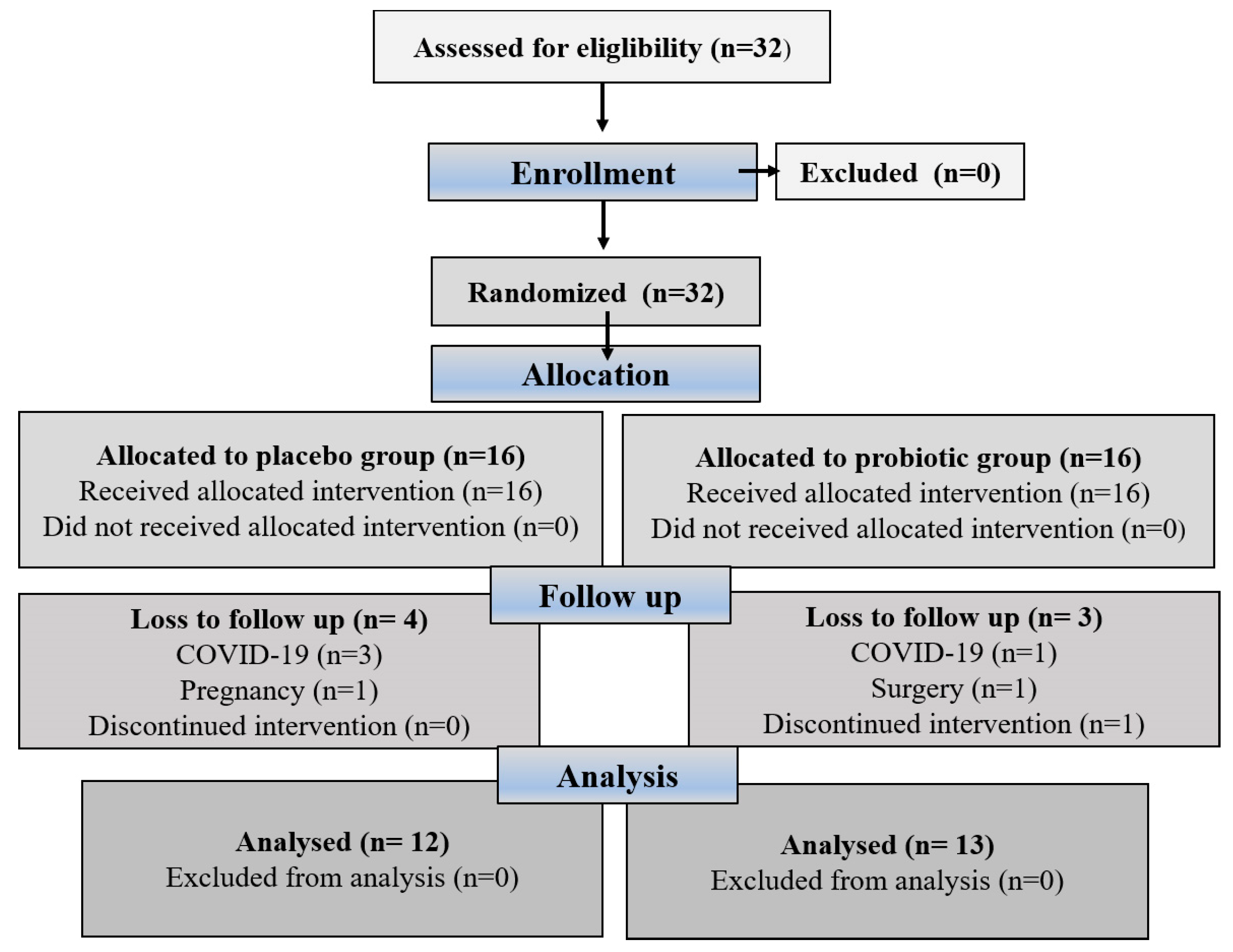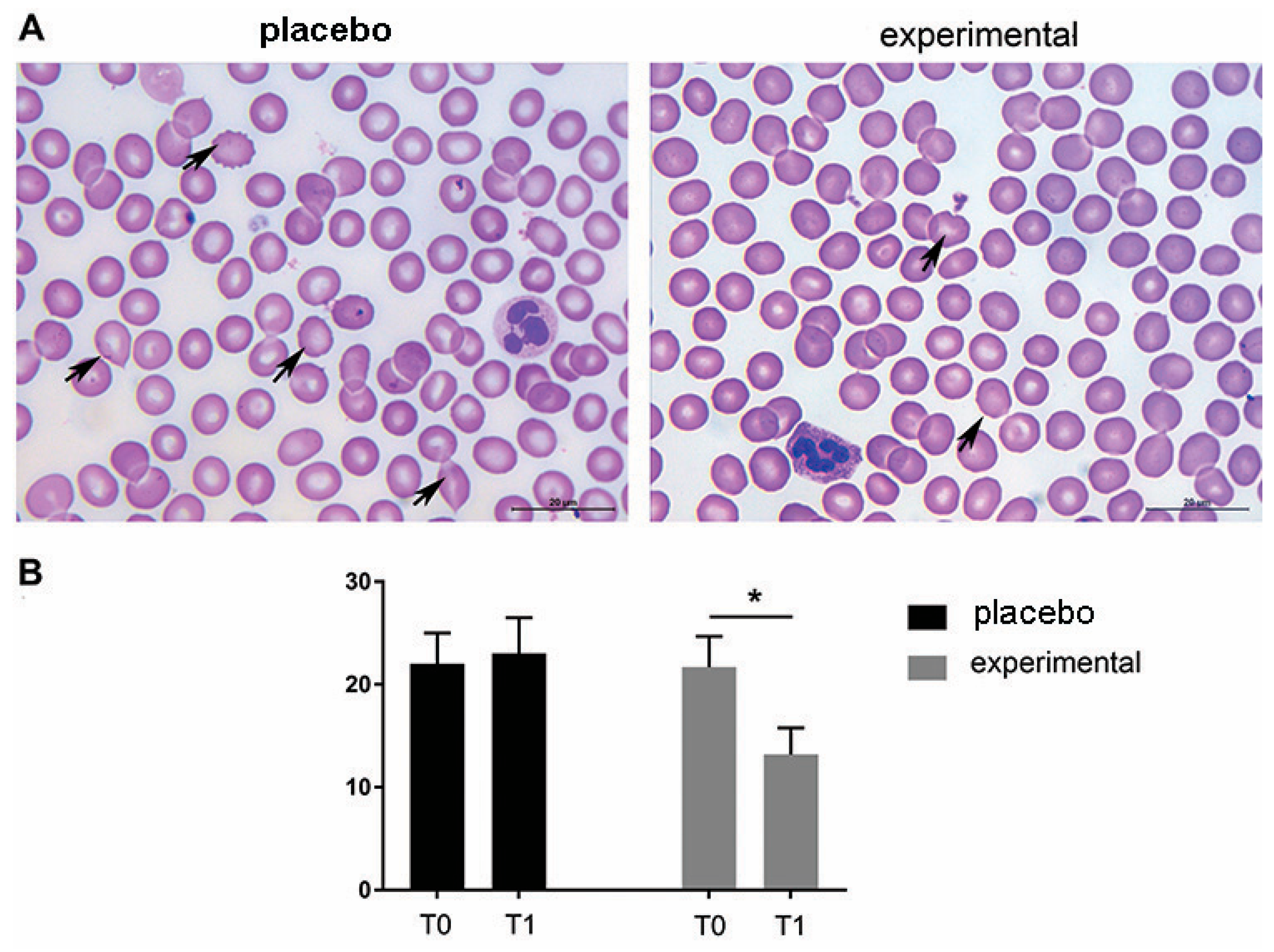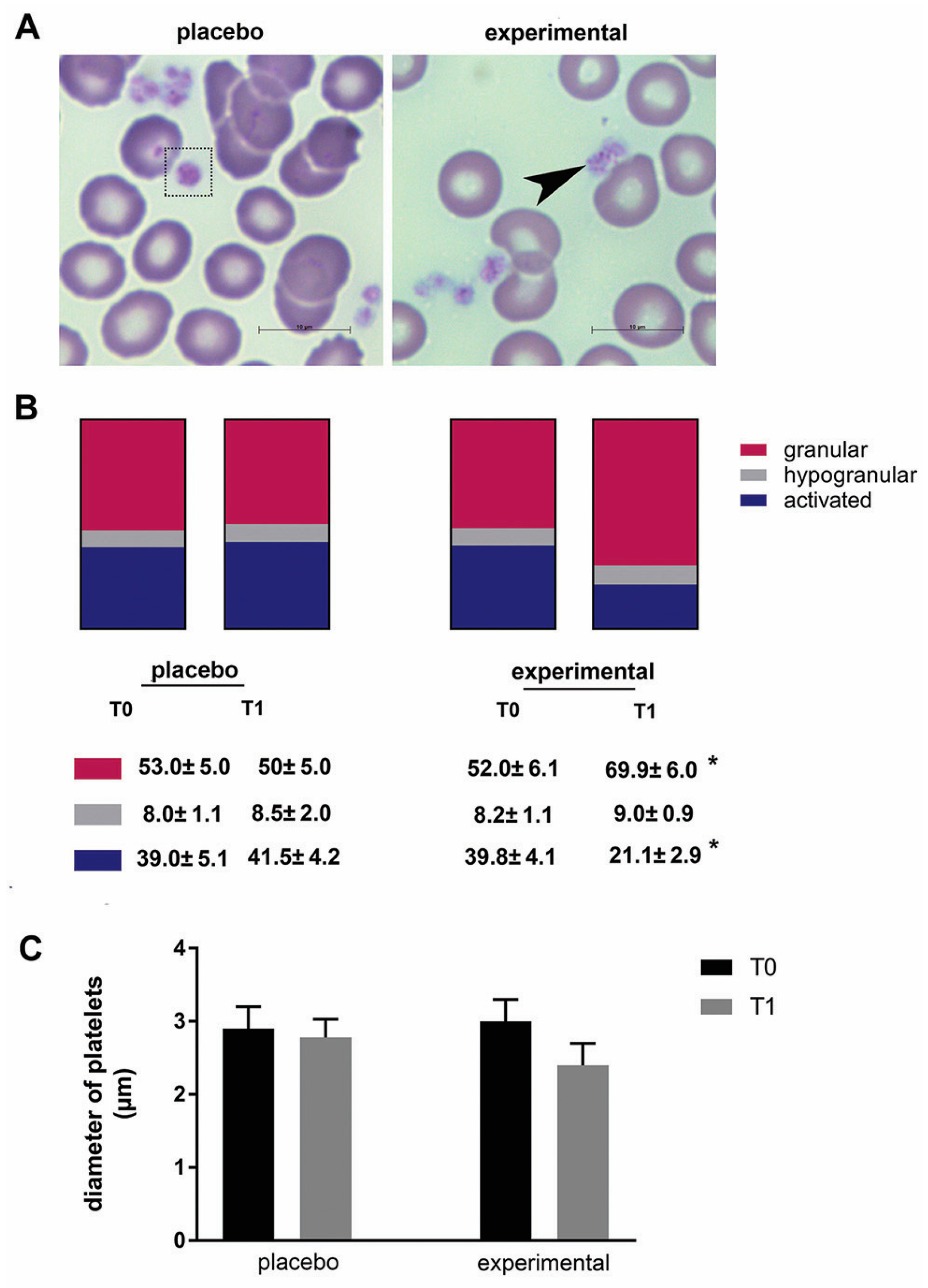Probiotic Supplementation Improves Hematological Indices and Morphology of Red Blood Cells and Platelets in Obese Women: A Double-Blind, Controlled Pilot Study
Abstract
1. Introduction
2. Materials and Methods
2.1. Study Design, Subjects and Eligibility Requirements
2.2. Nutritional Supplementation
2.3. Laboratory Tests of the Hematological Parameters
2.4. The Light Microscopic Examination of RBCs and Platelets Structural Alterations
2.5. Determination of Fibrinogen and sP-Selectin Levels
2.6. Statistical Analysis
3. Results
3.1. Hematological and Morphological Analysis of RBCs and Platelets
3.2. Analysis of Fibrinogen and sP-Selectin Changes
3.3. Correlation Between BMI and Hematological Parameters
4. Discussion
5. Conclusions
Author Contributions
Funding
Institutional Review Board Statement
Informed Consent Statement
Data Availability Statement
Acknowledgments
Conflicts of Interest
Abbreviations
| CRP | C-reactive protein |
| BMI | body mass index |
| RBCs | red blood cell count |
| RDW | red blood cell distribution width |
| Hgb | Hemoglobin |
| HCT | Hematocrit |
| MCV | mean corpuscular volume |
| MCH | mean corpuscular hemoglobin |
| MCHC | mean corpuscular hemoglobin concentration |
| PLT | platelet count |
| MPV | mean platelet volume |
| PDW | platelet distribution width |
| PCT | Plateletcrit |
| TNFα | tumor necrosis factor alpha |
| IL-6 | Interleukin 6 |
References
- Lin, X.; Li, H. Obesity: Epidemiology, Pathophysiology, and Therapeutics. Front. Endocrinol. 2021, 12, 706978. [Google Scholar] [CrossRef] [PubMed]
- Fernandez-Sanchez, A.; Madrigal-Santillan, E.; Bautista, M.; Esquivel-Soto, J.; Morales-Gonzalez, A.; Esquivel-Chirino, C.; Durante-Montiel, I.; Sanchez-Rivera, G.; Valadez-Vega, C.; Morales-Gonzalez, J.A. Inflammation, oxidative stress, and obesity. Int. J. Mol. Sci. 2011, 12, 3117–3132. [Google Scholar] [CrossRef]
- Kumar, R.; Mal, K.; Razaq, M.K.; Magsi, M.; Memon, M.K.; Memon, S.; Afroz, M.N.; Siddiqui, H.F.; Rizwan, A. Association of Leptin With Obesity and Insulin Resistance. Cureus 2020, 12, e12178. [Google Scholar] [CrossRef] [PubMed]
- Kumawat, M.; Choudhary, P.; Aggarwal, S. Association of Serum Leptin with Anthropometric Indices of Obesity, Blood Lipids, Steroidal Hormones, and Insulin Resistance in Polycystic Ovarian Syndrome. J. Hum. Reprod. Sci. 2021, 14, 228–233. [Google Scholar] [CrossRef] [PubMed]
- Jeong, H.R.; Lee, H.S.; Shim, Y.S.; Hwang, J.S. Positive Associations between Body Mass Index and Hematological Parameters, Including RBCs, WBCs, and Platelet Counts, in Korean Children and Adolescents. Children 2022, 9, 109. [Google Scholar] [CrossRef]
- Fujita, B.; Strodthoff, D.; Fritzenwanger, M.; Pfeil, A.; Ferrari, M.; Goebel, B.; Figulla, H.R.; Gerdes, N.; Jung, C. Altered red blood cell distribution width in overweight adolescents and its association with markers of inflammation. Pediatr. Obes. 2013, 8, 385–391. [Google Scholar] [CrossRef]
- Davi, G.; Guagnano, M.T.; Ciabattoni, G.; Basili, S.; Falco, A.; Marinopiccoli, M.; Nutini, M.; Sensi, S.; Patrono, C. Platelet activation in obese women: Role of inflammation and oxidant stress. JAMA 2002, 288, 2008–2014. [Google Scholar] [CrossRef]
- Bo, M.; Raspo, S.; Morra, F.; Cassader, M.; Isaia, G.; Poli, L. Body fat is the main predictor of fibrinogen levels in healthy non-obese men. Metabolism 2004, 53, 984–988. [Google Scholar] [CrossRef]
- Santilli, F.; Vazzana, N.; Liani, R.; Guagnano, M.T.; Davi, G. Platelet activation in obesity and metabolic syndrome. Obes. Rev. 2012, 13, 27–42. [Google Scholar] [CrossRef]
- Hou, J.; Liu, C.; Yao, P.; Chen, W.; He, M.; Wang, Y.; Liang, Y.; Miao, X.; Wei, S.; Xu, T.; et al. Association of Adiposity Indices with Platelet Distribution Width and Mean Platelet Volume in Chinese Adults. PLoS ONE 2015, 10, e0129677. [Google Scholar] [CrossRef]
- Davis, C.D. The Gut Microbiome and Its Role in Obesity. Nutr. Today 2016, 51, 167–174. [Google Scholar] [CrossRef] [PubMed]
- Wang, J.; Tang, H.; Zhang, C.; Zhao, Y.; Derrien, M.; Rocher, E.; van-Hylckama Vlieg, J.E.; Strissel, K.; Zhao, L.; Obin, M.; et al. Modulation of gut microbiota during probiotic-mediated attenuation of metabolic syndrome in high fat diet-fed mice. ISME J. 2015, 9, 1–15. [Google Scholar] [CrossRef] [PubMed]
- Koutnikova, H.; Genser, B.; Monteiro-Sepulveda, M.; Faurie, J.M.; Rizkalla, S.; Schrezenmeir, J.; Clement, K. Impact of bacterial probiotics on obesity, diabetes and non-alcoholic fatty liver disease related variables: A systematic review and meta-analysis of randomised controlled trials. BMJ Open 2019, 9, e017995. [Google Scholar] [CrossRef] [PubMed]
- Bernini, L.J.; Simao, A.N.; Alfieri, D.F.; Lozovoy, M.A.; Mari, N.L.; de Souza, C.H.; Dichi, I.; Costa, G.N. Beneficial effects of Bifidobacterium lactis on lipid profile and cytokines in patients with metabolic syndrome: A randomized trial. Effects of probiotics on metabolic syndrome. Nutrition 2016, 32, 716–719. [Google Scholar] [CrossRef]
- Obsen, T.; Faergeman, N.J.; Chung, S.; Martinez, K.; Gobern, S.; Loreau, O.; Wabitsch, M.; Mandrup, S.; McIntosh, M. Trans-10, cis-12 conjugated linoleic acid decreases de novo lipid synthesis in human adipocytes. J. Nutr. Biochem. 2012, 23, 580–590. [Google Scholar] [CrossRef]
- Okuka, N.; Schuh, V.; Krammer, U.; Polovina, S.; Sumarac-Dumanovic, M.; Milinkovic, N.; Velickovic, K.; Djordjevic, B.; Haslberger, A.; Ivanovic, N.D. Epigenetic Aspects of a New Probiotic Concept-A Pilot Study. Life 2023, 13, 1912. [Google Scholar] [CrossRef]
- Okuka, N.; Milinkovic, N.; Velickovic, K.; Polovina, S.; Sumarac-Dumanovic, M.; Minic, R.; Korcok, D.; Djordjevic, B.; Ivanovic, N.D. Beneficial effects of a new probiotic formulation on adipocytokines, appetite-regulating hormones, and metabolic parameters in obese women. Food Funct. 2024, 15, 7658–7668. [Google Scholar] [CrossRef]
- Ducrotté, P.; Sawant, P.; Jayanthi, V. Clinical trial: Lactobacillus plantarum 299v (DSM 9843) improves symptoms of irritable bowel syndrome. World J. Gastroenterol. 2012, 18, 4012–4018. [Google Scholar] [CrossRef]
- Hofeld, B.C.; Puppala, V.K.; Tyagi, S.; Ahn, K.W.; Anger, A.; Jia, S.; Salzman, N.H.; Hessner, M.J.; Widlansky, M.E. Lactobacillus plantarum 299v probiotic supplementation in men with stable coronary artery disease suppresses systemic inflammation. Sci. Rep. 2021, 11, 3972. [Google Scholar] [CrossRef]
- Bouaziz, A.; Dib, A.L.; Lakhdara, N.; Kadja, L.; Espigares, E.; Moreno, E.; Bouaziz, O.; Gagaoua, M. Study of Probiotic Effects of Bifidobacterium animalis subsp. lactis BB-12 and Lactobacillus plantarum 299v Strains on Biochemical and Morphometric Parameters of Rabbits after Obesity Induction. Biology 2021, 10, 131. [Google Scholar] [CrossRef]
- Everard, A.; Matamoros, S.; Geurts, L.; Delzenne, N.M.; Cani, P.D. Saccharomyces boulardii administration changes gut microbiota and reduces hepatic steatosis, low-grade inflammation, and fat mass in obese and type 2 diabetic db/db mice. mBio 2014, 5, e01011–e01014. [Google Scholar] [CrossRef] [PubMed]
- Arruzazabala, M.L.; Molina, V.; Mas, R.; Fernández, L.; Carbajal, D.; Valdés, S.; Castaño, G. Antiplatelet effects of policosanol (20 and 40 mg/day) in healthy volunteers and dyslipidaemic patients. Clin. Exp. Pharmacol. Physiol. 2002, 29, 891–897. [Google Scholar] [CrossRef] [PubMed]
- Zhou, Y.; Cao, F.; Luo, F.; Lin, Q. Octacosanol and health benefits: Biological functions and mechanisms of action. Food Biosci. 2022, 47, 101632. [Google Scholar] [CrossRef]
- Kadja, L.; Dib, A.L.; Lakhdara, N.; Bouaziz, A.; Espigares, E.; Gagaoua, M. Influence of Three Probiotics Strains, Lactobacillus rhamnosus GG, Bifidobacterium animalis subsp. Lactis BB-12 and Saccharomyces boulardii CNCM I-745 on the Biochemical and Haematological Profiles and Body Weight of Healthy Rabbits. Biology 2021, 10, 1194. [Google Scholar] [CrossRef]
- Marshall, P.N.; Bentley, S.A.; Lewis, S.M. Standardization of Romanowsky stains. The relationship between stain composition and performance. Scand. J. Haematol. 1978, 20, 206–212. [Google Scholar] [CrossRef] [PubMed]
- Zeigler, Z.; Murphy, S.; Gardner, F.H. Microscopic platelet size and morphology in various hematologic disorders. Blood 1978, 51, 479–486. [Google Scholar] [CrossRef]
- Rizzatti, V.; Boschi, F.; Pedrotti, M.; Zoico, E.; Sbarbati, A.; Zamboni, M. Lipid droplets characterization in adipocyte differentiated 3T3-L1 cells: Size and optical density distribution. Eur. J. Histochem. 2013, 57, e24. [Google Scholar] [CrossRef]
- Prion, S.; Haerling, K.A. Making sense of methods and measurement: Spearman-rho ranked-order correlation coefficient. Clin. Simul. Nurs. 2014, 10, 535–536. [Google Scholar] [CrossRef]
- Korniluk, A.; Koper-Lenkiewicz, O.M.; Kamińska, J.; Kemona, H.; Dymicka-Piekarska, V. Mean Platelet Volume (MPV): New Perspectives for an Old Marker in the Course and Prognosis of Inflammatory Conditions. Mediat. Inflamm. 2019, 2019, 9213074. [Google Scholar] [CrossRef]
- Furman-Niedziejko, A.; Rostoff, P.; Rychlak, R.; Golinska-Grzybala, K.; Wilczynska-Golonka, M.; Golonka, M.; Nessler, J. Relationship between abdominal obesity, platelet blood count and mean platelet volume in patients with metabolic syndrome. Folia Med. Cracov. 2014, 54, 55–64. [Google Scholar]
- Villarroya, F.; Cereijo, R.; Gavaldà-Navarro, A.; Villarroya, J.; Giralt, M. Inflammation of brown/beige adipose tissues in obesity and metabolic disease. J. Intern. Med. 2018, 284, 492–504. [Google Scholar] [CrossRef] [PubMed]
- Monteiro, R.; Azevedo, I. Chronic Inflammation in Obesity and the Metabolic Syndrome. Mediat. Inflamm. 2010, 2010, 289645. [Google Scholar] [CrossRef]
- Hamad, M.A.; Krauel, K.; Schanze, N.; Gauchel, N.; Stachon, P.; Nuehrenberg, T.; Zurek, M.; Duerschmied, D. Platelet Subtypes in Inflammatory Settings. Front. Cardiovasc. Med. 2022, 9, 823549. [Google Scholar] [CrossRef]
- Blair, P.; Flaumenhaft, R. Platelet alpha-granules: Basic biology and clinical correlates. Blood Rev. 2009, 23, 177–189. [Google Scholar] [CrossRef]
- Bourassa, K.A.; Postolache, T.T.; Dagdag, A.; Fuchs, D.; Okusaga, O.O. Plasma soluble P-selectin correlates with triglycerides and nitrite in overweight/obese patients with schizophrenia. Pteridines 2020, 31, 61–67. [Google Scholar] [CrossRef]
- Vayá, A.; Carmona, P.; Badia, N.; Hernandez-Mijares, A.; Bautista, D. Association between high red blood cell distribution width and metabolic syndrome. Influence of abdominal obesity. Clin. Hemorheol. Microcirc. 2011, 47, 75–77. [Google Scholar] [CrossRef]
- Vuong, J.; Qiu, Y.; La, M.; Clarke, G.; Swinkels, D.W.; Cembrowski, G. Reference intervals of complete blood count constituents are highly correlated to waist circumference: Should obese patients have their own “normal values?”. Am. J. Hematol. 2014, 89, 671–677. [Google Scholar] [CrossRef]
- Axling, U.; Onning, G.; Combs, M.A.; Bogale, A.; Hogstrom, M.; Svensson, M. The Effect of Lactobacillus plantarum 299v on Iron Status and Physical Performance in Female Iron-Deficient Athletes: A Randomized Controlled Trial. Nutrients 2020, 12, 1279. [Google Scholar] [CrossRef]
- Kaźmierczak-Siedlecka, K.; Daca, A.; Folwarski, M.; Witkowski, J.M.; Bryl, E.; Makarewicz, W. The role of Lactobacillus plantarum 299v in supporting treatment of selected diseases. Cent. Eur. J. Immunol. 2020, 45, 488–493. [Google Scholar] [CrossRef] [PubMed]
- Datta, S.; Timson, D.J.; Annapure, U.S. Antioxidant properties and global metabolite screening of the probiotic yeast Saccharomyces cerevisiae var. boulardii. J. Sci. Food Agric. 2017, 97, 3039–3049. [Google Scholar] [CrossRef] [PubMed]
- Bai, J.; Yang, T.; Zhou, Y.; Xu, W.; Han, S.; Guo, T.; Zhu, L.; Qin, D.; Luo, Y.; Hu, Z.; et al. Octacosanol Modifies Obesity, Expression Profile and Inflammation Response of Hepatic Tissues in High-Fat Diet Mice. Foods 2022, 11, 1606. [Google Scholar] [CrossRef]
- Wang, T.; Liu, Y.Y.; Wang, X.; Yang, N.; Zhu, H.B.; Zuo, P.P. Protective effects of octacosanol on 6-hydroxydopamine-induced Parkinsonism in rats via regulation of ProNGF and NGF signaling. Acta Pharmacol. Sin. 2010, 31, 765–774. [Google Scholar] [CrossRef]






| Parameter | Referent Values | Placebo | p Value | Experimental | p Value | ||
|---|---|---|---|---|---|---|---|
| T0 | T1 | T0 | T1 | ||||
| RBC (×1012L) | 3.86–5.08 | 4.77 ± 0.11 | 4.73 ± 0.01 | 0.709 | 4.59 ± 0.06 | 4.63 ± 0.07 | 0.671 |
| HGB (g/L) | 122–157 | 144.3 ± 11.4 | 150.4 ± 12.6 | 0.724 | 132.8 ± 3.1 | 133.6 ± 3.0 | 0.855 |
| HCT (L/L) | 0.356–0.47 | 0.4101 ± 0.007 | 0.4153 ± 0.007 | 0.990 | 0.4083 ± 0.005 | 0.4072 ± 0.008 | 0.910 |
| MCV (fL) | 83–97 | 85.5 ± 1.2 | 88.1 ± 1.1 | 0.123 | 88.9 ± 1.2 | 89.2 ± 1.4 | 0.873 |
| MCH (pg) | 27.4–33.9 | 28.1 ± 1.0 | 29.0 ± 0.5 | 0.358 | 28.8 ± 0.6 | 29.2 ± 0.5 | 0.611 |
| MCHC (g/L) | 320–360 | 324 ± 5.0 | 331 ± 3.0 | 0.234 | 325 ± 3.0 | 328 ± 3.0 | 0.487 |
| RDW (%) | 12–15.5 | 13.7± 0.3 | 14.8 ± 0.4 | 0.040 * | 14.9 ± 0.7 | 14.0 ± 0.4 | 0.905 |
| PLT (×109L) | 150–450 | 293.1 ± 13.4 | 294.2 ± 17.0 | 0.960 | 268.9 ± 11.7 | 262.1 ± 11.1 | 0.677 |
| MPV (fL) | 6.8–10.4 | 9.78 ± 0.41 | 9.76 ± 0.39 | 0.972 | 10.52 ± 0.37 | 10.08 ± 0.40 | 0.430 |
| PCT (%) | 0.158–0.425 | 0.294 ± 0.02 | 0.281 ± 0.01 | 0.557 | 0.285 ± 0.02 | 0.268 ± 0.01 | 0.444 |
| PDW (%) | 14–17.8 | 13.17 ± 0.4 | 13.02 ± 0.8 | 0.872 | 13.32± 0.5 | 13.75 ± 0.8 | 0.659 |
| Placebo n = 12 | Experimental n = 13 | |||
|---|---|---|---|---|
| Variable | r | p Value | R | p Value |
| RBC (×1012L) | 0.259 | 0.438 | 0.031 | 0.919 |
| Hgb (g/L) | −0.067 | 0.837 | −0.379 | 0.202 |
| HCT (L/L) | 0.059 | 0.865 | −0.236 | 0.437 |
| MCV (fL) | −0.358 | 0.251 | −0.357 | 0.232 |
| MCH (pg) | 0.023 | 0.951 | −0.528 | 0.067 |
| MCHC (g/L) | 0.232 | 0.489 | −0.522 | 0.071 |
| RDW (%) | 0.001 | 0.973 | 0.250 | 0.521 |
| PLT (×109L) | 0.210 | 0.533 | 0.442 | 0.116 |
| MPV (fL) | −0.133 | 0.678 | −0.147 | 0.646 |
| PCT (%) | 0.238 | 0.582 | 0.349 | 0.241 |
| PDW (%) | 0.232 | 0.489 | −0.591 | 0.049 * |
| Fibrinogen (g/L) | 0.071 | 0.906 | 0.200 | 0.613 |
| P-selectin (pg/mL) | 0.025 | 0.958 | 0.035 | 0.890 |
Disclaimer/Publisher’s Note: The statements, opinions and data contained in all publications are solely those of the individual author(s) and contributor(s) and not of MDPI and/or the editor(s). MDPI and/or the editor(s) disclaim responsibility for any injury to people or property resulting from any ideas, methods, instructions or products referred to in the content. |
© 2025 by the authors. Licensee MDPI, Basel, Switzerland. This article is an open access article distributed under the terms and conditions of the Creative Commons Attribution (CC BY) license (https://creativecommons.org/licenses/by/4.0/).
Share and Cite
Okuka, N.; Ivanovic, N.D.; Milinkovic, N.; Polovina, S.; Sumarac-Dumanovic, M.; Minic, R.; Djordjevic, B.; Velickovic, K. Probiotic Supplementation Improves Hematological Indices and Morphology of Red Blood Cells and Platelets in Obese Women: A Double-Blind, Controlled Pilot Study. Metabolites 2025, 15, 310. https://doi.org/10.3390/metabo15050310
Okuka N, Ivanovic ND, Milinkovic N, Polovina S, Sumarac-Dumanovic M, Minic R, Djordjevic B, Velickovic K. Probiotic Supplementation Improves Hematological Indices and Morphology of Red Blood Cells and Platelets in Obese Women: A Double-Blind, Controlled Pilot Study. Metabolites. 2025; 15(5):310. https://doi.org/10.3390/metabo15050310
Chicago/Turabian StyleOkuka, Nina, Nevena Dj. Ivanovic, Neda Milinkovic, Snezana Polovina, Mirjana Sumarac-Dumanovic, Rajna Minic, Brizita Djordjevic, and Ksenija Velickovic. 2025. "Probiotic Supplementation Improves Hematological Indices and Morphology of Red Blood Cells and Platelets in Obese Women: A Double-Blind, Controlled Pilot Study" Metabolites 15, no. 5: 310. https://doi.org/10.3390/metabo15050310
APA StyleOkuka, N., Ivanovic, N. D., Milinkovic, N., Polovina, S., Sumarac-Dumanovic, M., Minic, R., Djordjevic, B., & Velickovic, K. (2025). Probiotic Supplementation Improves Hematological Indices and Morphology of Red Blood Cells and Platelets in Obese Women: A Double-Blind, Controlled Pilot Study. Metabolites, 15(5), 310. https://doi.org/10.3390/metabo15050310







